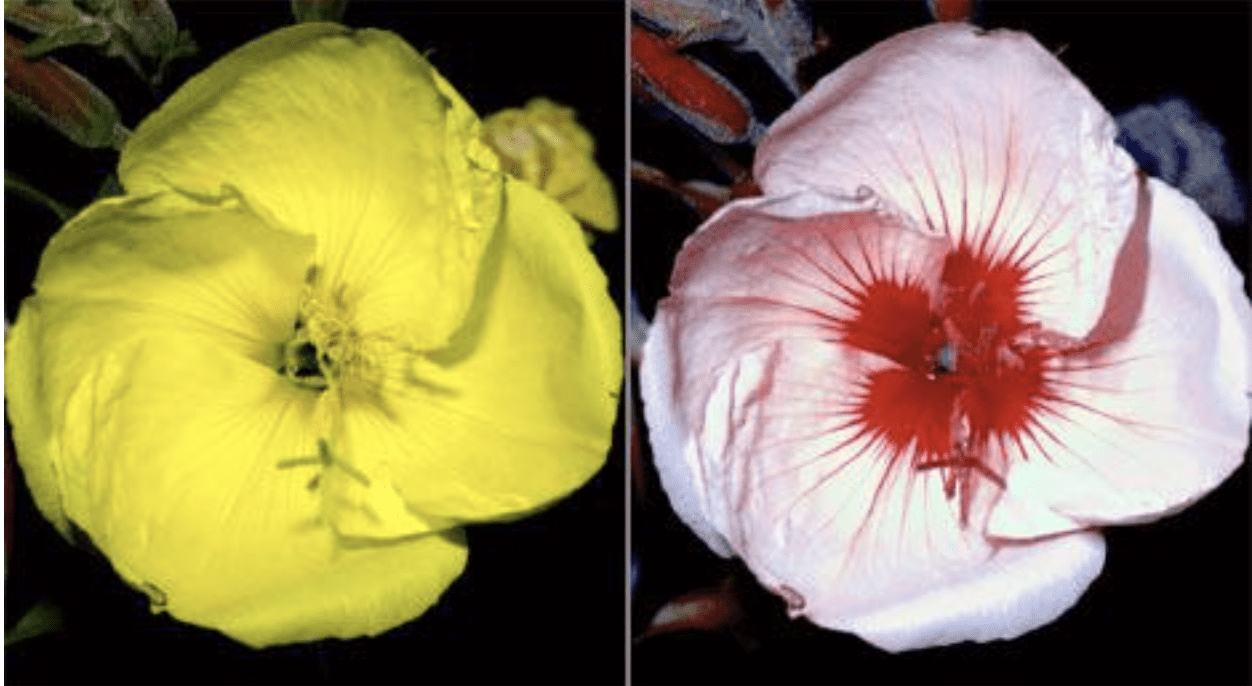A couple of weeks ago, I read a fascinating article that talked about how chemical sprays—both pesticides and fertilizers—negatively impact beneficial insects by altering the electrical field around flowers, making bumblebees less likely to land on them for pollination. “Flowers have electrical fields around them? You must be kidding,” I thought. It had never even occurred to me.
There are other aspects of a flower’s appearance that is not what it seems when it comes to how insects perceive it. When I watched David Attenborough’s fascinating documentary Kingdom of Plants several years ago, I was particularly intrigued by how different a bee’s view is from mine. Their ultraviolet viewpoint totally transforms what the flower looks like.

We see the flower on the left, big, beautiful and yellow. The bee sees the image on the right with a big bullseye in the center and narrow paths radiating into the center, beckoning it to come and pollinate. Unfortunately, a large number of the beautiful hybrid double flowers that we so enjoy don’t have the flashing landing strip lights that say, Here is the place to come for some yummy pollen. Some of them don’t even have pollen. So much as I like these flashy hybrids, I always make sure there are plenty of flowers that I know will attract birds and bees and other pollinators.
So what does this have to do with Women’s History Month and Mary and Martha, you might wonder? Well, part of what I love about my changing perspective of God’s world is that it opens me to new perspectives of the Scriptures as well. I particularly have my eyes and ears open for new understandings on the place of women in the early church.
A few years ago, Mary Stromer Hanson in her book The New Perspective on Mary and Martha—Do Not Preach Mary and Martha Again Until You Read This! questioned our interpretation of the story where Mary is praised for sitting at Jesus’ feet and Martha is reprimanded for working hard in the kitchen, as told in Luke 10:38-42. First, we read into the story things that are not really there, like our assumption that Jesus arrives with a hoard of disciples and forces Martha to scurry around to get a meal for them. However, all the text explicitly states is that Jesus entered a village and was welcomed by Martha. Hanson suggests that this was actually a one-on-one conversation.
Hanson believes that Mary and Martha were both ministry leaders in the church: Martha with a “house church” and ministry in her local village, and Mary as a kind of traveling evangelist, spreading the good news of Christ to other villages. She suggests that the King James version of Luke 10:39 is more accurate than others. It says, “And she had a sister called Mary, which also sat at Jesus’ feet, and heard his word.”
According to Hanson, since “sitting at the feet” is a figurative description rather than a literal one, Mary is not necessarily physically seated at Jesus’ feet while Martha addresses him. In her presentation, Hanson said that, “sitting at the feet,” as in Acts 22:3, is the traditional vocabulary of discipleship. So both Martha and Mary are known as “sitters at the feet” or disciples of Jesus. This is a figurative description, not literal.
Martha addresses Jesus directly in Luke 10:40, because Mary, again according to Hanson, isn’t even there. While Martha is struggling to keep up with the local village ministry, Mary is traveling around ministering abroad. Martha wants Jesus to deliver a message to Mary when he encounters her in his travels, asking her to return and assist Martha in the village ministry (A New View of Mary and Martha, by Mark M Mattison).
Hanson also proposes an alternative translation of verse 42. She translates tēn agathēn merida (literally, “the good portion”) not superlatively (as in “the best portion”) but rather positively (as in “a good thing”). In other words, Mary’s choice of ministering abroad isn’t necessarily better than Martha’s choice of ministering to the village; Mary’s choice of itinerant ministry is equally good. Hanson’s contention is that both Mary and Martha were prominent leaders and Mary probably had a very effective evangelistic ministry in drawing others to follow Jesus. (Read Hanson’s entire paper here.)
In a similar way that our perception of the world around us needs to be revisited, I’m convinced that many of our interpretations of biblical stories need to be revisited, and Women’s History Month seems like a good time to do some of this revisiting. Flowers are not what we first perceive them to be, and new information continues to be gathered to broaden our understanding and the ways in which we respond to them. Gospel stories like this one are the same. We always need to have our eyes and our ears open to new facts that help us understand the complete story.
 Christine Sine co-founded (with her husband, Tom) Mustard Seed Associates, a network of followers of Jesus that seeks to unleash the creative potential of Jesus followers. She writes books about and conducts seminars on sustainability, simplicity, spirituality, and gardening.
Christine Sine co-founded (with her husband, Tom) Mustard Seed Associates, a network of followers of Jesus that seeks to unleash the creative potential of Jesus followers. She writes books about and conducts seminars on sustainability, simplicity, spirituality, and gardening.


